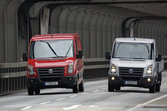The Crafter BlueTDI - Now Even More Economical and Greener with Adblue Technology And a New Gearbox
 |
HANOVER, GERMANY - April 23, 2009: Volkswagen Commercial Vehicles is making the engines in the Crafter model range compliant with the Euro 5 exhaust standard. From June onwards, Crafter vehicles will be equipped with environmentally friendly AdBlue technology as standard. This means the nitrous oxides contained in the exhaust are converted into harmless nitrogen and water. In conjunction with a new manual gearbox, this means fuel consumption is reduced by 0.9 litres per 100 kilometres, while CO2 emissions are cut by up to 23 g/km. As a result, the Crafter is one of the cleanest transporters in its class. What is more, it meets European EEV limit values (Enhanced Environmentally friendly Vehicle). AdBlue technology is known to be an effective method of exhaust purification in the truck and bus sector. It involves a harmless 32.5 percent aqueous urea solution added to the exhaust tract to convert the nitrous oxides contained in the exhaust into nitrogen and water at a catalytic converter.
Furthermore, cooled exhaust gas recirculation (EGR) is used in the engine in order to reduce nitrous oxides. AdBlue technology allows the exhaust recirculation rate to be reduced slightly in this case. This means the TDI engine can once again be operated closer to the optimum thermodynamic point. The efficiency of the engine is increased, while particulate emissions and consumption go down.
In combination with the redesigned six-speed manual gearbox that permits a moderate reduction in engine speed in the higher gears, this adds up to an overall reduction in fuel consumption by as much as 0.9 l/100 km compared to the Euro 4 predecessor model. CO2 emissions thereby drop by as much as 23 g/km. Furthermore, the Euro 5 adaptation goes hand in hand with a torque increase for each of the four available TDI engines, amounting to between 7 and 14 percent depending on the power level from 65 to 120 kW.
All in all, these new features of the Crafter with commercial vehicle registration mean that the vehicle not only meets the requirements of the Euro 5 exhaust standard but indeed goes well beyond what this standard demands in terms of particulates, hydrocarbon and carbon monoxide emissions. As a result, it has even been possible to achieve certification as an EEV (Enhanced Environmentally friendly Vehicle), which is currently the most exacting European exhaust standard for buses and trucks.
Elaborate technology, straightforward handling and replenishment free
of charge
In order to purify the exhaust, the urea solution is
injected into the exhaust tract according to a characteristic map based on
the load status. AdBlue consumption is up to one percent of the amount of
diesel consumed. At in excess of 200 degrees Celsius, the urea (which
contains nitrogen) is converted into ammonia (NH3) within a fraction of a
second. This ammonia reacts with the nitrous oxides (NOX) at the catalytic
converter to produce nitrogen (N2) and water (H2O). Exhaust post-treatment
is supplemented by a diesel particulate filter (DPF) with an upstream
oxidation catalytic converter. The new DPF has a filter volume that is 10
percent higher and, in conjunction with a new temperature control concept,
this ensures that regeneration control is optimised.
Working with AdBlue could hardly be more straightforward: a separate tank carries up to 29 litres of the reduction agent. In the box van, the tank is filled via the engine compartment whereas there is a filler neck on the tank itself in vehicles with open bodies. During the first three years, filling as part of a service will be performed free of charge by the service partner.
If the level in the tank drops below a certain level before the next service is due, a warning light indicates that there is only a small amount remaining. A reminder for replenishment indicates if the remaining range has dropped to 2400 km or below. It is a statutory requirement for the torque to be reduced by 25 percent if this distance is driven without the tank being replenished.
It is always necessary to refill the tank fully for the system to be reset automatically. As well as special filling pumps, 10 litre containers are available from retail outlets for this purpose. Any replenishing costs incurred outside scheduled workshop visits during the first three years will be refunded by the Volkswagen service partner upon presentation of the receipt.


